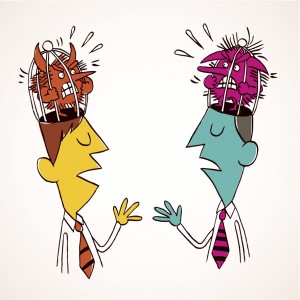
If a treatment is powerful enough to have a good effect, then it’s powerful enough to have a bad effect. This is well recognised when it comes to medication, with strict regulations in place to ensure adverse outcomes are monitored and measured.
By contrast, psychotherapy has never been as readily associated with the potential to cause harm. Whatever the basis of this assumption, it doesn’t always quite ring true. We already know that several forms of therapy can be potentially hazardous, including critical incident debriefing, ‘boot camps’ and grief counselling for normal bereavement (Lilienfeld 2007, Barlow 2010, Nutt et al 2009, Berk et al 2009). The team working on the huge STAR*D trial noted that even CBT appeared to increase suicidal ideation in some patients (Sinyor et al 2010), and 15 of the 198 patients with psychosis in Klingberg et al’s 2012 trial of CBT versus cognitive remediation for negative symptoms suffered severe adverse events (Klingberg et al 2012).
So with psychotherapy being capable of causing unwanted effects, just like any other potentially effective treatment, it would seem important that such occurrences are monitored, measured and crucially, carefully reported in trials. In a manner similar to how we discuss side effects of drugs, patients are entitled to information about potential side-effects of psychotherapy thus allowing them to make balanced and informed decisions about their care.
The CONSORT guidelines make this process straightforward and widespread for drug trials, but the rate at which adverse events are being monitored in randomised controlled trials of psychotherapy was unclear, that is until two papers published this year (Vaughan et al 2014, Jonsson et al 2014).

We associate side effects more with drug treatments, but any therapy that’s powerful enough to have a good effect may also have a bad effect
Methods
Vaughan et al performed a Medline search of high impact (impact factor >5) psychiatry and psychology journals for randomised controlled trials of Axis I disorders (all mental health diagnoses except personality disorder and learning disability). They only included phase II, III or IV drug trials and psychotherapy trials of “commonly used” modalities like CBT or supportive therapy. They then chose 15 trials at random from each of the following groups:
- Medication trials
- Psychotherapy trials
- Combined medication and psychotherapy trials
Two of the authors rated each of the trials for mentioning possible or actual adverse events of treatments in the following categories:
- Medication in medication trials (M)
- Psychotherapy in psychotherapy trials (T)
- Medication in combined trials (CM)
- Psychotherapy in combined trials (CT)
Each section of each paper (introduction, methods, results, discussion) was rated, as well as each paper as a whole. When it wasn’t clear if the harm being discussed in a combined trial was in reference to the drug or the psychotherapy, the consideration was ascribed to both groups.
Jonsson et al looked at a much larger sample of studies, but they chose not to include any control group of medication trials. They searched Pubmed for trials of any psychological intervention for any mental or behavioural disorder according to ICD-10 that had been published in the year 2010. One author searched each study for several keywords associated with adverse events using the “find” tool, and then manually as well. A second author then screened the results sections of the papers for a consensus.

Vaughan et al found that all drug trials reported on side effects, compared with 60% of psychotherapy trials
Results
Vaughan et al found significant differences between their groups. Whereas 100% of medication trials (M) demonstrated an awareness of possible or actual adverse events, only 60% of psychotherapy trials (T) did so.
In combined trials of medications and psychotherapy, adverse events were discussed in relation to medication 86.7% of the time, but in relation to psychotherapy only 60% of the time (p=0.018). Adverse events were discussed in 100% of the methods and result sections of medication trials, but only in 46.7% of methods (p=0.001) and 40% of results (p=0.020) sections of psychotherapy trials.
When medication (M) and medication in combined trials (CM) were added together, 93% of trials discussed adverse effects, whereas when psychotherapy (T) and psychotherapy in combined trials (CT) were added together, that number was only 60% (OR 9.33, CI 1.87 to 46.66, p=0.007).
Jonsson et al’s search strategy turned up 3,696 studies, all but 132 of which were excluded. Anxiety (23%) and mood (13%) disorders were the most commonly studied problems and CBT (52%) was the most common intervention. Europe and North America both hosted 41% of the trials and 73% of the trials were conducted on working age adults.
Just 28 (21%) trials indicated that harms, adverse events or side effects were monitored.
Four trials included full reports of adverse events and how these were monitored:
- One trial of CBT for childhood PTSD used a checklist
- One trial of behavioural therapy for children with Tourette disorder used a series of structured questions
- One trial systematically assessed PTSD symptoms at the end of every session of exposure therapy
- One 2-year trial of a family intervention in schizophrenia had monthly assessments for relapse by a psychiatrist
Another 24 trials showed some consideration of the potential for adverse events:
- Five trials gave some information about adverse events in their results sections but had missing or incomplete details
- Four trials reported that no adverse events occurred, but gave no more information
- Fifteen trials didn’t report adverse events as such, but did measure deterioration using a variety of tools. Only three of these mentioned how many patients actually deteriorated.
The other 79% of trials gave no indication of having considered adverse events at all, one even stating in the methods section that the treatment was “not deemed harmful”.
Half of the trials of interventions for PTSD considered adverse events, far more than trials on interventions for any other diagnosis (25% at most).

Jonsson et al sifted through 3,696 studies published in 2012 and found that only 21% of psychotherapy trials indicated that harms, adverse events or side effects were monitored
Summary of results
These two important studies suggest that trials of psychotherapeutic interventions report potential and actual harms infrequently. Vaughan et al reported that harms were considered in only 60% of psychotherapy interventions in their sample compared to 100% of medication interventions, and Jonsson et al found that only 21% of psychotherapy trials published in 2010 mentioned harms.
Strengths and weaknesses
Between them, the two trials boast various strengths. Jonsson et al were comprehensive in studying every trial from a single year, lending reliability to their results. By looking at each trial in detail, they discovered that PTSD trials were more likely to consider harms, which is a salient point.
Vaughan et al, in contrast, made an illuminating comparison with medication. By finding that harms were reported significantly less in every section of psychotherapy papers, including the introduction, they suggest that not considering harms is a cultural problem, not just an immediately methodological one. The study of PTSD, as noted above, may be an except to this, because researchers are already primed for the idea that their participants may come to harm – as they already have.
Both papers had flaws though – Jonsson et al lacked a control group, whereas Vaughan et al chose to study a small selection of papers, making generalising their results tricky. Also, by selecting papers from only high impact journals, which have more stringent selection criteria, Vaughan et al may have overestimated the rates of reporting on harms – a possibility that is backed up by the more inclusive Jonsson et al study finding a lower reporting rate. Neither could, of course, account for harms being considered by authors but not being explicitly mentioned in final manuscripts.

Trials of PTSD were more likely to consider and report harms
Discussion
However you look at it, the results are hard to ignore – psychotherapy trials need to monitor, measure and report on adverse events more frequently. How can this be achieved?
Firstly, there needs to be far better recognition of the problem. Accepting the potential for psychotherapy to cause adverse events, as all effective treatments can, needs to become common parlance. Perhaps, as Vaughan et al suggest, this current situation is due to us:
thinking of the process of therapy in nomothetic or generalized terms rather than idiographic or individualized terms, enabling clinicians to de-emphasize specific cases and outcomes.
Secondly, researchers need tools that help them to differentiate between the various causes of deterioration during psychotherapy, so they can actually spot harms and report them appropriately. The lack of such tools has undoubtedly been a hindrance to reporting adverse events in the past. It’s not as straightforward as identifying drug side effects, where consequences such as rashes and vomiting are obviously attributable to the treatment in question – psychotherapy is a complex, multi-faceted process, the effects of which can prove nearly impossible to disentangle from life events themselves. Michael Linden can help here; he presents definitions of unwanted events, treatment-emergent reaction, adverse treatment reaction, malpractice reaction, treatment non-response, deterioration of illness, therapeutic risk, and contraindications, which could make discerning the difficult types of adverse events easier (Linden 2013). The development of CONSORT-SPI, a psychotherapy equivalent of the structure medication trials adhere to, is ongoing and will surely also prove useful.
At the very least, authors should report if no harm-related data were collected, and both ethics and guideline committees need to be alert to this responsibility.
Monitoring for harms, and therefore making it clear to patients that they may occur, may have an interesting effect on the efficacy of psychotherapy in trials. No longer in the dark about potential harms, some patients may get worse simply by being aware that they might. This nocebo effect is well-known in drug trials, and although it is in constant competition with the beneficial placebo effect, it can only decrease the effectiveness of an intervention. But we must be honest with our patients.
Also of note, reporting on harms might be a free shot at killing the Dodo effect. If some therapies turn out to be more harmful than others, it could seriously influence choice of treatment – just like the weight of side effects with some drugs make them less suitable choices than equally effective alternatives. Drop out rates – often seen as lower than that in drug trials – still need to be factored into these calculations.

Researchers, clinicians and patients need to accept the potential for psychotherapy to cause adverse events
Conclusion
In conclusion, to say that psychotherapy trials do not report on harms frequently enough is not to say that psychotherapy is ineffective, unscientific, or necessarily even harmful. It is to say that there are valuable improvements to be made in psychotherapy trial designs. These improvements will result in psychotherapists being able to offer their patients more information about the interventions they propose, to better recognise how and when and which of those interventions are best used, and ultimately to offer more effective, comprehensive and ethically honest care.

The lack of evidence about the potential harms of psychotherapies makes treatment decisions more difficult
Links
Vaughan B et al. Frequency of reporting of adverse events in randomized controlled trials of psychotherapy vs. psychopharmacotherapy. Compr Psychiatry. 2014 Jan 23. pii: S0010-440X(14)00006-6. doi: 10.1016/j.comppsych.2014.01.001. [Epub ahead of print] [PubMed abstract]
Jonsson U, Alaie I, Parling T, Arnberg FK. Reporting of harms in randomized controlled trials of psychological interventions for mental and behavioral disorders: A review of current practice. Contemp Clin Trials. 2014 Mar 4;38(1):1-8. doi: 10.1016/j.cct.2014.02.005. [Epub ahead of print] [PubMed abstract] [Accepted manuscript PDF]
Lilienfeld SO. Psychological treatments that cause harm (PDF). Perspect Psychol Sci 2007;2:53–70.
Barlow DH. Negative effects from psychological treatments: a perspective (PDF). Am Psychol 2010;65:13–20. [PubMed abstract]
Nutt DJ, Sharpe M. Uncritical positive regard? Issues in the efficacy and safety of psychotherapy (Researchgate PDF, requires registration). J Psychopharmacol 2008;22:3–6. [PubMed abstract]
Berk M, Parker G. The elephant on the couch: side-effects of psychotherapy. Aust N Z J Psychiatry 2009;43:787–94. [PubMed abstract]
Sinyor M, Schaffer A, Levitt A. The Sequenced Treatment Alternatives to Relieve Depression (STAR*D) Trial: A Review. The Canadian Journal of Psychiatry 2010, 55 (3): 126–135. [PubMed abstract]
Klingberg S, Herrlich J, Wiedemann G, Wölwer W, Meisner C, Engel C, Jakobi-Malterre UE, Buchkremer G, Wittorf A. Adverse effects of cognitive behavioral therapy and cognitive remediation in schizophrenia: results of the treatment of negative symptoms study. J Nerv Ment Dis. 2012 Jul;200(7):569-76. doi: 10.1097/NMD.0b013e31825bfa1d. [PubMed abstract]
Linden M. How to define, find and classify side effects in psychotherapy: from unwanted events to adverse treatment reactions. Clin Psychol Psychother. 2013 Jul-Aug;20(4):286-96. doi: 10.1002/cpp.1765. Epub 2012 Jan 18. [PubMed abstract]


@Mental_Elf: Say ‘Psychotherapy trials should report the side effects of treatment http://t.co/G4SxjZT2Bc‘ #mentalhealth #MentalIllness
My @Mental_Elf blog on psychotherapy trials not reporting adverse events. Co-author: the shy and retiring @Keith_Laws http://t.co/luQSo3OB12
.@PsychiatrySHO @Mental_Elf @Keith_Laws interesting read. Thank you
@PsychiatrySHO @nuwandiss @Mental_Elf @Keith_Laws Useful stuff, thanks. I always worried my adverse response to Mindfulness was nonsense.
@Mental_Elf agreed! Also Dr etc should discuss side effects of meds with patients too #MentalHealthAwareness
“@Mental_Elf: Psychotherapy trials should report the side effects of treatment http://t.co/gCUyYiwaPK”. It’s time to change
@Mental_Elf Very interesting reading. Adverse effects and deterioration have been overlooked in research.
@Mental_Elf Interestingly, a project looking at adverse effects of psychological therapy is being presented at the May @bacp research conf.
@Clare_Symons @Mental_Elf @BACP sounds really interesting. Is the abstract or any further info online?
@Clare_Symons @Mental_Elf @BACP Hurrah, as a victim of poor therapy, with no 1 slightest bit interested in outcome, or what this led to
The lack of evidence about the potential harms of psychotherapies makes treatment decisions more difficult http://t.co/yYtbiKLLMc
Psychotherapy trials for PTSD more likely to consider and report harms http://t.co/yYtbiKLLMc However, 50% is far from satisfactory
“@Mental_Elf: Psychotherapy trials should report the side effects of treatment http://t.co/LGHPnbp6MB” @SalfordPsych @SalfordAPT Good points
@Mental_Elf Yes! Acknowledge importance Reporting of Side Effects/Complications is Step 1.Notable 2,if ineffective>opportunity costs 2 Rx~
Psychotherapy trials should report the side effects of treatment http://t.co/rZB94r4fni via @sharethis
Psychotherapy trials should report on the side effects of treatment – The Mental Elf http://t.co/sqPrTifPVC
Today @PsychiatrySHO & @Keith_Laws summarise 2 recent studies looking at the reporting of harms in psychotherapy RCTs http://t.co/rmdgOiaDiZ
@Mental_Elf Very thought provoking.
Any therapy that’s powerful enough to have a good effect may also have a bad effect http://t.co/rmdgOiaDiZ
@Mental_Elf Also, further info here about the AdEPT project – very interesting stuff: http://t.co/AK6pBdkhC8
RT @Keith_Laws: Psychotherapy & harms http://t.co/QgXGG971Ek @Mental_Elf article by @PsychiatrySHO & myself has links to PDFs of key recent…
#Psychotherapy trials should report the side effects of treatment #mhsm #research http://t.co/v9YJOjo84Y
RT @Mental_Elf: If psychotherapy is capable of causing adverse effects, these should be monitored, measured & reported in trials http://t.c…
RT @PsychiatrySHO: My @Mental_Elf blog today with @Keith_Laws on the low rates of reporting of adverse effects in psychotherapy trials http…
Do all therapists accept the potential for psychotherapy to cause adverse events? http://t.co/rmdgOiaDiZ
patients entitled to info about potential side-effects of psychotherapy “@Mental_Elf: http://t.co/XlmgoFFjMI” #mentalhealth
RT @Mental_Elf: Jonsson et al found that only 21% of psychotherapy trials published in 2010 mentioned harms http://t.co/rmdgOiaDiZ
RT @Mental_Elf: Trials of #PTSD are more likely to consider and report harms of psychotherapies http://t.co/rmdgOiaDiZ
Researchers need tools to help recognise deterioration during psychotherapy, spot harms & report them appropriately http://t.co/rmdgOiaDiZ
The CONSORT-SPI reporting guideline will help researchers report the adverse effects of psychotherapy @SPI_Oxford http://t.co/rmdgOiaDiZ
Why do so many people seem to assume psychotherapy won’t have negative consequences? Great, from @Mental_Elf http://t.co/MqhggwO3rg
Important points well made. Though I don’t see that disclosure of possible harms necessarily only has a nocebo effect that can ‘only decrease the effectiveness”. As I recall some placebo effects have been hypothesised to be due to adverse effects being interpreted as a sign that a medication must be having a real/strong effect, and therefore possibly a therapeutic effect. Also, I guess, honest caring disclosure could increase trust in the therapist which could increase effectiveness.
@suzypuss @lexthepup @SameiHuda @GeorgiaBelam As we say http://t.co/TuX0ATKIZj we need to know & reveal possible harms of talk therapy
Does anyone have a coding system/method to assess adverse events in psychotherapy? @Mental_Elf please RT.
@sci_pract @Mental_Elf Michael Linden proposes such a model (the UE-ATR) in http://t.co/r6n563bQ88. http://t.co/kwmrZ0AoFW
It is very important for researchers and clinicians to discuss the potential negative outcomes as well as the potential benefits of an intervention. Unfortunately, psychotherapeutic research has often focussed too heavily on two forms of therapy; that which easily conforms to positivist frameworks (e.g CBT), and approaches that are at the more obscure end of the spectrum. This leaves a whole world of therapeutic approaches under-explored, and yet lumped into an unrepresentative whole. Those of us who are lucky enough to be able to work as clinicians as well as researchers know that research rarely captures the complexity / messiness of real life in today’s society. Psychological therapies have for too long tried (often erroneously) to conform to the standards of medical practice. The problems are exacerbated by journals that have a ‘scientific’ tradition which leads to sampling techniques and outcome measures that further distance research from practice. Most of us whether we access services or not, are complex individuals, trying to navigate the turbulence of today’s pressured society. We are not easily boxed, and attempts to place us in neat boxes for research, loses something significant. Trying to do so with outcome appraisals (both positive and negative) is equally flawed. I would hope that all researchers and therapists talk to their clients / participants about the possible risks / dangers / problems that can arise. I also hope that we all continually appraise how a person’s wellbeing is being impacted on by our work. However, asking us to do so in a manner ‘similar to reporting the side-effects of drugs’ is an apples-oranges comparison. I do not want to see psychological therapy conforming too closely to the standards of medicine, we are different disciplines. Conforming to the position of another profession results in making the same mistakes that profession makes. I do not want to see an ‘anti-psychology’ movement arising. However, we must of course take a caring, sensible, collaborative and open approach to our work. We owe it to the people we work with, our profession, and society as a whole.
@ClinpsychLucy Did you read the blog? http://t.co/rmdgOiaDiZ @PsychiatrySHO @Keith_Laws
@Mental_Elf Skimmed it. Dislike medical/ drug metaphors for human relationships – which is what therapies are a vehicle for
@Mental_Elf @ClinpsychLucy Don’t think clear-enough distinction between adv events and adv effects & though imp, therapy harms ≠ med harms.
@rb_mcr @Mental_Elf The @CEP_UK is intending to rectify latter. Powerful presentations today by @JoannaMoncrieff & Peter Gotsche.
@rb_mcr @Mental_Elf Peter Gotsche, eminent researcher, likens Pharma activities to organised crime. Powerful stuff. Earl Sandwich supports!!
@rb_mcr @Mental_Elf A number of other sympathetic Noble Lords, MPs & journalists there today. There’s a feeling of change in the air…..
@ClinpsychLucy @Mental_Elf Had just seen your other tweet with CEP link, v interesting, powerful stuff for sure. To misquote Churchill…
@ClinpsychLucy @Mental_Elf Never in the field of human medicine has so little been known by so many.
@maddoggiejo @Mental_Elf @PsychiatrySHO @Keith_Laws Does this work? – http://t.co/zfGCioYb1e
@SteWeatherhead @Mental_Elf @PsychiatrySHO @Keith_Laws nope my KGB is going nuts about it
@maddoggiejo @Mental_Elf @PsychiatrySHO @Keith_Laws Sorry, I’m not technologically-minded enough to help.
@maddoggiejo The link to our blog? Try this: http://t.co/kPahf0TEiV
@Mental_Elf dammit same thing, firewall goes nuts..give me a summary in a sentence
Danger talks http://t.co/BlxYgVVNy3 ongoing #pillshaming Medicate or not, therapy or not? ppl need support, they usually give hint #listen
Here’s an important post by @PsychiatrySHO for @Mental_Elf on the under-researching of side effects for psychotherapy http://t.co/PguHG0j1kg
@thus_spake_z @MarkOneinFour @PsychiatrySHO @Mental_Elf ‘Dr as drug’ side effects noted in 1955 by @BalintSocietyUK http://t.co/CQMmfK06zm
@thus_spake_z @MarkOneinFour @PsychiatrySHO @Mental_Elf 60 years is a long time for findings to be ignored
As @PsychiatrySHO rightly says, any treatment that has a good effect can have a bad effect, including psychotherapy http://t.co/PguHG0j1kg
Interesting blog from @Mental_Elf written by @PsychiatrySHO and @Keith_Laws http://t.co/eXxywVyYMc I’ve posted a bedtime comment. Goodnight.
RT @ciarakirke: Really interesting blog by @Keith_Laws&@PsychiatrySHO re. need to report adverse effects of psychotherapy http://t.co/Aiiaq…
RT @Mental_Elf: We’ve had a great response to our blog about the adverse effects of psychotherapy by @PsychiatrySHO & @Keith_Laws http://t.…
RT @Mental_Elf: Don’t miss: Psychotherapy trials should report the side effects of treatment http://t.co/rmdgOiaDiZ
@LeighGTurner @Mental_Elf Psychotherapy trials should report the side effects of treatment http://t.co/iD6Pmbrf4U via @sharethis
Blog comment from @ahider about iatrogenic risk from psychotherapy for BPD http://t.co/t9fkKKrIpZ @PsychiatrySHO @Keith_Laws Tx Andrew
We need to be aware of costs as well as benefits – http://t.co/MoVw0ZyeoG
Psychotherapy trials should report the side effects of treatment http://t.co/at4dnBUupu Why the avoidance?
Thank you for succinctly articulating a clear, present and generally ignored threat to the welfare of psychotherapy clients. We now track client outcomes session-by-session, across our national network, for this very reason.
Potential negative effects of psychological therapies – definitely an area that needs much more attention: http://t.co/9m8xG6UsZF
Reporting negative impact of #Psychotherapy in studies http://t.co/TlUGsqgHks via @Mental_Elf by @Keith_Laws @PsychiatrySHO & links to PDFs
thought provoking blog by @PsychiatrySHO and @Keith_Laws on side effects in psychotherapy research http://t.co/TzTQvbD5XA
@PsychiatrySHO I mean a “Council for evidence-based talk therapies like those you describe here”: http://t.co/gQQYZaCLie
Full disclosure?: Psychotherapy trials should report the side effects of treatment http://t.co/SfIRHFrkVi @PsychiatrySHO @Mental_Elf
RT @Mental_Elf: Most popular blog this week? @PsychiatrySHO & @Keith_Laws on the adverse effects of psychotherapy http://t.co/rmdgOiaDiZ
This is an important subject. Whatever else it may entail, therapy is at its heart a conversation between two people, and of course not all conversations are helpful. Surely the important question is: what makes therapy conversations more or less, helpful? In order to answer this question, we need to attend very closely to what people say who have experienced therapy. There are a growing number of published first-person accounts available, as well as more formal qualitative research. This listening and responsiveness is also vital on a moment by moment basis within the therapy conversation itself. I’m worried by our current tendency to view therapy as a ‘thing’ that can be applied wholesale to another thing (‘depression’, say) in a manner analogous to administering a drug. As someone said recently, therapy is an intervention that is ‘manufactured at the point of delivery’. Everyone is different and everyone finds different things helpful. The therapist brings knowledge of approaches and ideas that CAN be helpful, but only the client can say which of these ‘fit’ his or her particular situation. As in other conversations, sensitivity to the other person on a moment by moment basis is surely the best way to ensure that our therapy conversations are as helpful as possible.
Therapy isn’t applying a thing to another thing, it’s a conversation & needs to be a sensitive one. http://t.co/epGqOfDE0D @SteWeatherhead
Leer! Psychotherapy trials should report on the side effects of treatment – The Mental Elf http://t.co/kNe4nQbEln por @PsychiatrySHO
RT @Mental_Elf: Researchers, clinicians and patients need to accept the potential for psychotherapy to cause adverse events http://t.co/rmd…
Anything that works has side effects; issue is type, severity and frequency. Underreported in psychotherapy research http://t.co/R2NqbVsprP
Psychotherapy trials should report the side effects of treatment, say @psychiatrySHO and @Keith_Laws http://t.co/u1ZJ5Xr6E0 #psychotherapy
Supporting safe therapy http://www.supportingsafetherapy.org/ a new website that comes out of the School of Health and Related Research at Sheffield University’s research into harm caused by psychotherapy
RT @bengoldacre: We help nobody when we pretend that psychotherapy has no side effects via @Mental_Elf @Keith_Laws @PsychiatrySHO http://t.…
despite potential harm, psychotherapy studies rarely report side effects (tho less so for PTSD): http://t.co/umyFHirEDs, via @Mental_Elf
Documenting psychotherapy trials is important. Like meds there are side effects that need regulation http://t.co/uCJQmNwiVS via @bengoldacre
This is very interesting. MT @bengoldacre: We help nobody when we pretend that psychotherapy has no side effects http://t.co/9jWW7XI4ee #fb
Consumers harmed in therapy report they find next to nothing from the psych profession on the subject, what they do uncover has no relation to their experience. Or the literature blames them for the breakdown via accusations of projection, transference, resistance or narcissism. It’s even been stated clients fail to improve to undermine the therapist. I see no substantiation for these “insights” and to chronicle them strikes me as commiserate to claiming clairvoyance.
It’s difficult to measure outcome because it’s difficult to measure the quality of a human life. Has anyone a definition of emotional wellness? Clients also might leave therapy in a sugar-rush of positivity, their practitioners glowing with accomplishment, only to find themselves at baseline or below once the buzz wears off. Folie à deux is a difficult measure statistically.
Providers seem to underestimate the indoctrination taking place in their practice–a client surrendering judgment a priest-like figure in exchange for hope of relief from life’s pain.
It’s curious that psychotherapy seems to allow so little berth for critics. One hopes that what is claimed as such a spectacular treatment would endure the test of scrutiny.
disequilibrium1.wordpress.com/
[…] Langford A, Laws K. Psychotherapy trials should report on the side effects of treatment [Internet]. The Mental Elf. 2014 [cited 2015 Oct 21]. Available from: http://www.nationalelfservice.net/treatment/psychotherapy/psychotherapy-trials-should-report-the-sid… […]
[…] We have quite recently seen a publicly funded trial of a psychological intervention halted because of worryingly higher rates of adverse events (overdose, self-harm and suicide attempts) in the intervention arm of the trial (McMurran et al 2011). Two quite different recent reviews (Vaughan et al, 2014; Jonsson et al, 2014) have confirmed the low rates at which adverse events are monitored in randomised controlled trials of psychotherapy. […]
If a treatment is powerful enough to have a good effect, it’s powerful enough to have a bad effect https://t.co/PXlXniHFja #psychotherapy
@Mental_Elf Hmm. Not sure about this “if..then”. And where is the power when it is not in a pill? In the method, therapist, relationship…?
https://t.co/4WmWsfhBs1 This is a very good article and something we need to address.
@SameiHuda @afwesty @Keith_Laws You’re talking about different blogs
1. 30/4/14 https://t.co/PXlXniHFja
2. 26/4/16 https://t.co/A08Wo8UVqk
[…] is also an issue. We know that only half of psychotherapy trials measure and report on the side effects of treatment, compared to 100% of drug trials in psychiatry. People say that talking treatments are unlikely to […]
[…] familiar with the lack of evidence about the potential harms of psychotherapy from previous blogs (Langford & Laws 2014; Laws & Huda, 2016). The publication of the Negative Effects Questionnaire (NEQ; Rozental A et […]
[…] not measure this or simply that the reviewers were not interested in adverse effects. We know that only half of psychotherapy studies measure or report on the side effects of treatment, but clearly any intervention powerful enough to have a positive effect, will also have a negative […]
[…] as with pharmacological interventions and any other talking therapy, that psychoanalysis can cause harm if used […]